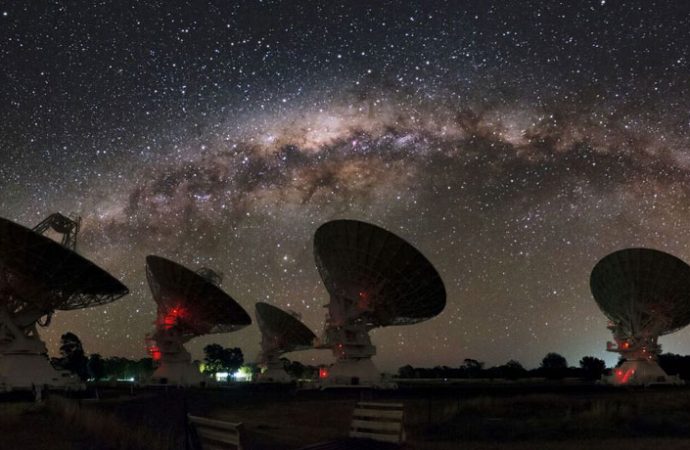The burst of light from far away may have been a new type of supernova
Astronomers may have discovered a new way that stars can die. A mysteriously brief and bright burst whimsically called the “Cow” reveals an entirely new type of stellar death.
The details of that stellar doom, however, remain hazy. Scientists are still debating whether the flare-up, spotted on June 16, 2018, was from an unusual type of star that was eaten by a black hole, or from an old, massive star exploding in a weird sort of supernova.
The Asteroid Terrestrial-impact Last Alert System telescope in Hawaii first detected the explosion, and gave the event the random name AT2018cow. “It was immediately dubbed, to avoid this mouthful of letters, the Cow,” said astronomer Daniel Perley in a news conference January 10 at the American Astronomical Society meeting.
Right away, the Cow was weird. The first observations showed that it came from a star-forming dwarf galaxy about 200 million light-years away in the constellation Hercules. But the Cow was particularly bright for being so far away, suggesting it was about 10 times the luminosity of a typical supernova and 100 billion times the luminosity of the sun. It also appeared suddenly, going from invisible to peak brightness in just two days, far faster than most ordinary supernovas.
“This combination of being very fast and very luminous is very unusual,” said Perley, of Liverpool John Moores University in England. “Many of us got very excited.”
Over the following months, a slew of telescopes rushed to follow up on the Cow in wavelengths of light spanning the electromagnetic spectrum, from long radio waves to short gamma rays. “The Cow has become one of the most intensely observed cosmic events in history,” said astronomer Anna Ho of Caltech at the meeting.
Those follow-up observations revealed that the Cow was surrounded by dense material moving at a tenth of the speed of light. The burst of light also lasted for several months, growing gradually dimmer across a range of wavelengths. Although it was dimming overall, sometimes it grew brighter in small irregular jumps, suggesting there’s something continually feeding energy to the explosion from the inside, Perley said.
Quick change
Using several telescopes, astronomers saw a cosmic flare nicknamed the “Cow” brighten and fade. The Sloan Digital Sky Survey observed the Cow’s host galaxy in 2003 (left), when the Cow was nowhere in sight. The green circle shows where the flare later appeared. Then the Liverpool Telescope saw the Cow on June 20, 2018, when it outshone the galaxy (center). The William Herschel Telescope saw the Cow about a month after its peak brightness, when the flare had faded (right).

Daniel Perley/Liverpool John Moores Univ.
One possible explanation for the explosion is a star getting torn apart by a black hole, called a tidal disruption event. Astronomers have seen such hapless stars succumb to black holes in other galaxies. The way the Cow’s brightness faded over time was consistent with those previous observations, said astronomer Amy Lien of NASA’s Goddard Space Flight Center in Greenbelt, Md., at the meeting.
But it couldn’t be an ordinary star being devoured by an ordinary black hole. The flare was so short and ramped up so quickly that the star must have been very small, weighing only about 0.1 to 0.4 times the mass of the sun. That means it could have been a dense white dwarf, the end stage of stars like the sun. Astronomers have never seen a white dwarf being shredded by a black hole before.
The black hole could have been between 100,000 and 1 million times the mass of the sun, which is almost as much as the black hole at the center of the Cow’s host galaxy. The surprising thing about this black hole is that it’s not located in the galaxy’s center, so astronomers still have to explain how such a massive black hole ended up in the galactic outskirts.
The other best option is a new kind of supernova explosion, the researchers reported. The fast, high-energy light that the Cow emitted over the months after its discovery could be explained by swiftly moving debris fleeing the explosion and plowing through some other dense material, said astrophysicist Raffaella Margutti of Northwestern University in Evanston, Ill.
Margutti and Ho think the supernova, if it occurred, could have produced a fast-spinning black hole. If that black hole gathered up material from the debris of the explosion, that would release the kind of energy Ho’s team observed. Astronomers have seen stars die in supernovas before, and they’ve detected the black holes that such explosions can leave behind. “But the connection between the deaths and the formation of the corpse has not really been made,” Ho says.
There could be many manifestations of stellar death, and the few versions astronomers know about, such as ordinary supernovas and other explosions called gamma-ray bursts, could be small parts of a wider landscape, Ho says. “There’s a whole zoo of things that we’re only starting to discover now,” she says. “Linking all those together and saying how they’re related is still very much an open question.”
Astronomers will continue to watch the Cow as it fades, observations that could help solve the stellar mystery.
Source: Science News

































Leave a Comment
You must be logged in to post a comment.